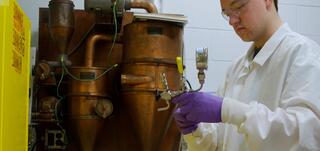Breaking down bioenergy crops

Ammonia fiber expansion (AFEX) pretreatment of plant-derived feedstocks increases the yield of biofuels and bioproducts.
The Science
A vital step in making biofuels and bioproducts from bioenergy crops is deconstructing plant biomass and releasing the plant’s sugar polymers. Ammonia fiber expansion (AFEX) is a pretreatment that uses heat and chemical energy to break down plant cell walls and allow enzymes easier access to convert the sugar polymers inside into sugars, which can be subsequently converted into fuels and chemicals. Scientists at the Great Lakes Bioenergy Research Center (GLBRC) have developed a standard operating procedure for performing AFEX pretreatment of bioenergy crops that can be safely applied at a lab-scale.
Standard Operating Procedure
Watch the video above or online at jove.com »
The Impact
AFEX pretreatment is a promising method to produce highly digestible plant biomass that can be used directly as animal feed or as a feedstock to generate fuels and chemicals. GLBRC scientists have developed a detailed standard operating procedure for the safe and consistent operation of laboratory-scale AFEX pretreatment of lignocellulosic biomass.
Summary
AFEX pretreatment uses volatile ammonia and water as reactants to breakdown recalcitrant lignocellulosic biomass. The advantage of this pretreatment is that it preserves the original biomass composition and produces dry biomass that can be easily shipped, unlike other similar processes. AFEX also produces fewer microbial inhibitors that could decrease the yield of biofuels and bioproducts during biological fermentation. GLBRC scientists presented a detailed standard operating procedure for conducting lab-scale AFEX pretreatment of lignocellulosic biomass where ammonia could be recycled, reducing the cost of the process. AFEX pretreatment generated highly digestible material, especially from grasses and grass-based agricultural residues, and resulted in a three-fold increase in glucose and xylose released after enzymatic hydrolysis as compared to untreated biomass. The procedure can be conducted in any laboratory with proper ventilated space, materials, and safety precautions. This lab-scale process is perfect for testing biomass at higher throughput while providing insights on how the process would perform at larger scales. AFEX is a promising pretreatment for plant biomass used to make biofuels and bioproducts, and the method might find use in other areas such as the production of biomaterials or biogas.
Program Manager
N. Kent Peters
Program Manager, Office of Biological and Environmental Research
kent.peters@science.doe.gov, 301-903-5549
Corresponding Author
Rebecca Ong
Assistant Professor, Michigan Technological University
rgong1@mtu.edu, (906) 487-2662
Funding
This material is based upon work supported in part by the Great Lakes Bioenergy Research Center, U.S. Department of Energy, Office of Science, Office of Biological and Environmental Research under Award Numbers DE-SC0018409 and DE-FC02-07ER64494. Partial support from Michigan Technological University, the National Science Foundation CBET award (1604421), ORAU Ralph E. Powe Award, Rutgers School of Engineering, Michigan State University AgBioResearch office, the USDA National Institute of Food and Agriculture, State of Texas and University of Houston.
Publications
Chundawat, S.P.S., et al. “Ammonia Fiber Expansion (AFEX) Pretreatment of Lignocellulosic Biomass.” Journal of Visualized Experiments 158, e57488 (2020). [DOI: 10.3791/57488]
Related Links
https://www.jove.com/v/57488/ammonia-fiber-expansion-afex-pretreatment-of-lignocellulosic-biomass
https://www.jove.com/t/57488/ammonia-fiber-expansion-afex-pretreatment-of-lignocellulosic-biomass